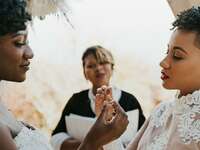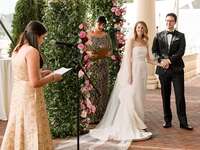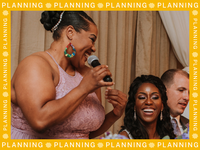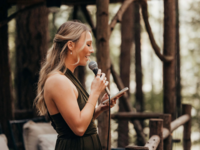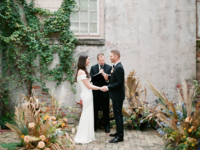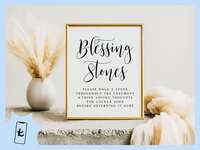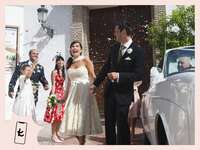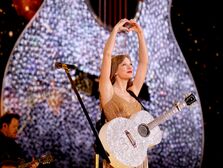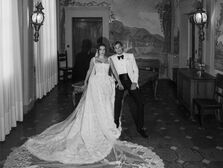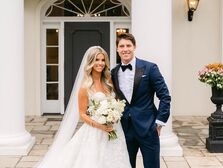Everything to Know About Mormon Wedding Traditions
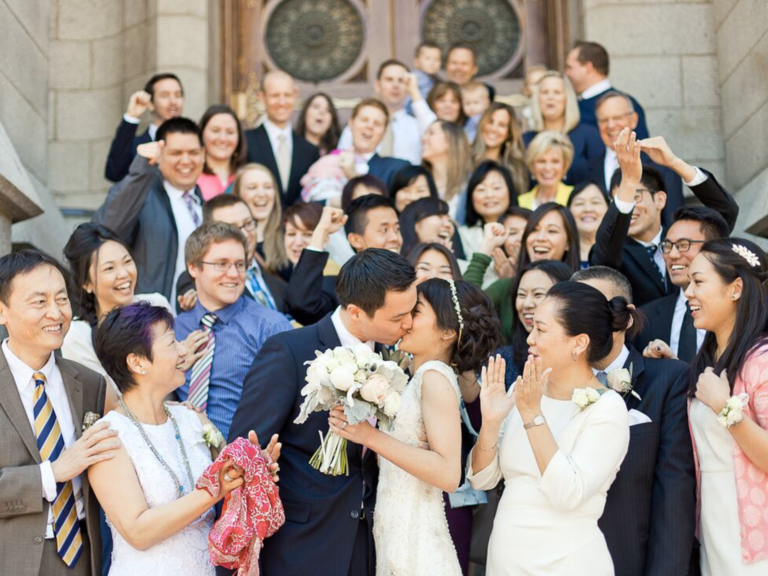
Whether you're planning a Mormon wedding or attending one as a guest, it's important to understand the traditions surrounding this celebration of faith and love. This can include a sacred temple wedding, traditional wedding attire and sometimes more than one wedding reception. Mormons, or those who are members of The Church of Jesus Christ of Latter-Day Saints (LDS), incorporate their faith in many aspects of their wedding, especially the ceremony. With the help of expert executive planner Heather Hull with Michelle Leo Events based in Salt Lake City, Utah, we gathered everything to know about Mormon wedding practices.
Mormon wedding traditions you should know: History | Attire | Ceremony | Reception
A Brief History of Mormon Wedding Traditions
Mormon wedding traditions originated from Bible verses about marriage and the Latter-Day Saints' belief that marriage is part of God's plan for his people. Their faith states that during a marriage sacrament, or ceremony, a couple pledges themselves to each other and God. These traditions began when the church was founded in the mid-19th century.
Traditional Mormon Wedding Attire
Attire at a Mormon wedding includes modest wedding apparel and traditional religious garments symbolic of Biblical text. Here's what to expect when it comes to Mormon wedding garments.
Temple Wedding Attire
"At a wedding held in an LDS temple, the bride and groom wear traditional white temple clothing for the ceremony," Hull explained. Temple wedding clothing is bright white and is symbolic of purity. Other Mormon wedding attire can include bonnets and a veil for the bride.
Green Fig Leaf Apron
Sometimes the to-be-weds each wear a green apron with a fig leaf pattern. This is tied around their waist over their temple clothing. The pattern symbolizes the fig leaves that Adam and Eve used to cover themselves in the Garden of Eden.
Reception Wedding Attire
"Following the ceremony, the couple changes into their wedding attire before exiting the temple," Hull said. This can include a suit for the groom and a modest wedding dress for the bride. The couple's wedding party often wears the same attire throughout the day.
Mormon Wedding Ceremony Traditions
Mormon proposal traditions and pre-wedding celebrations are similar to other weddings in the US, including engagement parties, wedding showers and rehearsal dinners. However, a Mormon wedding ceremony is unlike other traditional weddings. While you might not see a grand wedding ceremony entrance or a string quartet in a temple ceremony, here's what often takes place during a Mormon wedding.
Mormon Temple Wedding
"Weddings for members of The Church of Jesus Christ of Latter-Day Saints are typically held in LDS temples, a building dedicated for sacred worship for those of this faith," Hull said. "A temple wedding ceremony may incorporate readings from scripture, quotes and guidance for the couple from trusted leaders. The ceremony includes blessings and promises made to the couple and their family." Mormon weddings in the temple are typically 30 to 45 minutes long.



Only those who follow the Mormon faith are allowed to enter the temple. Couples and their guests are required to have a temple recommendation issued by a church leader or bishop to attend a temple wedding. Couples might choose to host a civil ceremony and a temple wedding on the same day so all of their guests can attend. Also, while a Mormon can marry a non-Morman, the ceremony would have to take place outside of a Latter-Day Saints temple.
Wedding Sealing Ceremony
An important part of a Mormon temple wedding ceremony is the temple sealing. It is believed that couples married in an LDS temple are married for eternity, including into the afterlife. During this type of wedding ceremony the to-be-weds join hands and kneel in front of each other at an altar. As part of the traditional wedding vows the couple promises to be sealed, to honor and love each other and commit themselves to the teachings of the church. They receive a wedding blessing to be together for time and all eternity.
Mormon Wedding Ring Exchange
Couples sometimes choose to exchange wedding bands after their temple ceremony. "Because exchanging rings is not an official part of the temple wedding ceremony, couples may elect to have a separate ceremony to exchange rings," Hull said. "This ring ceremony is held at a different location, following the temple ceremony and before the wedding reception."
Mormon Wedding Reception Traditions
Mormon wedding receptions are large parties or intimate gatherings that reflect the couple's style. They include dancing, a bouquet toss and a celebratory send-off.
Open House Mormon Reception
"LDS receptions are often a flowing, open house style event with many invited guests attending throughout the evening to congratulate the couple and their families," Hull said. "Receptions may also be an evening of select family, friends and guests invited to dine and celebrate with the couple. Wedding traditions such as the couple's first dance and parent dances along with cake cutting, bouquet toss and a couple send-off may be observed during the reception."
Mormon Wedding Reception Food
"Reception menu items are chosen to suit the couple's preferences with no specific traditional food or drinks served," Hull said. While there is no set wedding food at a Mormon reception, there are a few things you won't find. This includes alcohol, coffee or tea, as those of the LDS faith do not consume them. But wedding guests might not even miss these among the delicious food and desserts on the menu.
Second Wedding Reception
After the honeymoon, the couple might host an additional wedding reception. Hull said depending on where the families reside and the wedding takes place, the couple may choose to have a second reception or open house at a later date. This way they can celebrate with different groups of family and friends.

